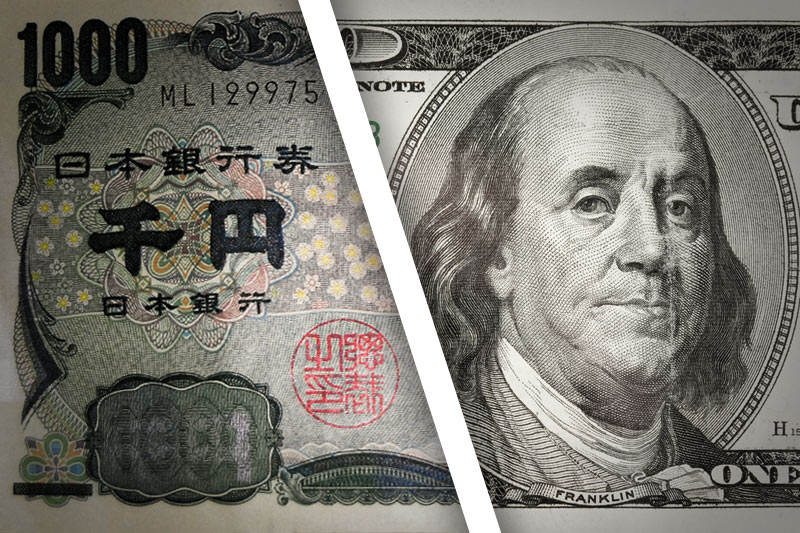Investing.com - The Japanese yen has hit its lowest level against the U.S. dollar for over 30 years, inviting speculation from financial analysts about whether possible intervention is on the cards.
USD/JPY movements
At 11:15 ET (15:15 GMT), the USD/JPY pair traded marginally lower at ¥151.19, having earlier in the session climbed as high as ¥151.97, the weakest level for the Japanese yen against the U.S. dollar since 1990.
This move has fueled speculation that the BoJ may intervene soon to support its currency.
Chris Turner, head of FX strategy at ING, told Investing.com that he believes that "intervention was more likely close to 155 than 152."
"...One could see a scenario where USD/JPY does break above 152, pushes one to three big figures higher as momentum traders jump in, but then the BoJ comes in with large intervention," Turner said.
He reminded FX traders that the BoJ sold around $70 billion in FX intervention back in 2022, with the first rounds normally the largest.
"What may be interesting this time around, since they are tightening policy, is that they might not sterilise this intervention, i.e. they may withdraw yen from money markets – rather than sterilising and add the yen back to markets that they might normally do with super loose policy."
The yen has been on the backfoot for some time – the USD/JPY pair is over 38% higher over the last three years – with the yen the lowest-yielding G10 currency.
This makes it ideal for carry trades, in which an investor borrows in a currency with low interest rates and invests the proceeds in a higher-yielding currency.
Bank of Japan interest rate changes
The Bank of Japan raised interest rates to around 0% earlier this month for the first time since 2007, a move that marked a historic shift in monetary policy as the central bank made a landmark exit from negative interest rates.
However, this move had been widely flagged, and has done little to support the yen.
Short-term Japanese rates are still 0.1% and only about 20 further basis points in hikes are priced this year. The U.S. Fed funds rate, by contrast, is 5.25%-5.5% and a 25 bp cut isn't fully priced until July.
This means that further gains are likely unless Japanese authorities take steps to dissuade foreign exchange traders.
The currency pair has already broken the level that drew intervention in 2022, the last time Japanese authorities stepped into the market.
Japan's three main monetary authorities – the Bank of Japan, the Finance Ministry and Japan's Financial Services Agency – held an emergency meeting on Wednesday to discuss the currency.
In a briefing afterwards, Japan’s vice finance minister for international affairs Masato Kanda said he "won't rule out any steps to respond to disorderly FX moves".
Earlier this week, Kanda had said the government will “take appropriate action against excessive fluctuations, without ruling out any options.”
That said, “this may still be only a ‘verbal intervention’ range,” said analysts at ING, in a note, with another USD/JPY leg higher needed for actual FX intervention to be deployed (perhaps closer to 155).”
“Remember that Japanese authorities look at the rate of change more than levels,” ING added.
Yen forecast for 2024
The forceful nature of these comments tends to suggest that USD/JPY is capped at this stage, “but the stars are not aligned to be short outright here,” said analysts at Citi, in a note Wednesday.
“The market still needs to see the policy paths starting to diverge (in the U.S. especially) for more downside for USD/JPY in particular,” Citi added.
Analysts at UBS agreed that the USD/JPY exchange rate has limited room for further gains in the near term, given the potential for Japanese government bond yields to rise toward 1%, and for a further rise in USD/JPY to draw even stronger concerns from Japanese policymakers.
Additionally, the market’s anticipation of rate cuts by the Federal Reserve should also limit the rebound potential for U.S. yields and the dollar.
“We still think the currency pairing is ‘toppish’ and should trend lower in the second half of this year,” analysts at the Swiss bank said, in a note.
On whether BoJ intervention will work, Turner argues that the market wants "to see short-dated US rates come lower – like they did last Nov/Dec to really turn USD/JPY around."
Why is Japan’s interest rate so low?
Japan's central bank has conducted massive monetary easing since 2013, cutting interest rates to negative levels as it sought to end decades of deflation and restore healthy consumer price growth.
However, economic conditions have started to pick up, with sharply rising wages suggesting sustainable inflation and less need for these very accommodative monetary policies.
While a weaker yen helps Japanese exporters' profits, it can but can squeeze households by increasing import costs, which eventually filter their way into rising consumer prices.
Stay of top of the USD/JPY cross
There’s likely to be plenty to keep an eye on as the USD/JPY currency cross movements continue to play out. Thankfully, with the interactive charts and historical currency info available right here on investing.com, investors can keep up with live data.
